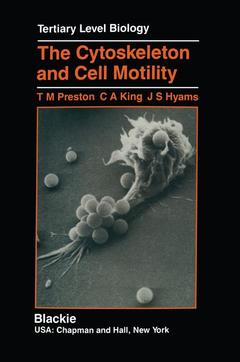Description
The Cytoskeleton and Cell Motility, Softcover reprint of the original 1st ed. 1990
Tertiary Level Biology Series
Authors: Preston T.M., King C.A., Hyams J.S.
Language: English
Subject for The Cytoskeleton and Cell Motility:
Approximative price 126.59 €
In Print (Delivery period: 15 days).
Add to cart
Publication date: 06-2012
202 p. · 14.3x21.6 cm · Paperback
202 p. · 14.3x21.6 cm · Paperback
Description
/li>Contents
/li>
This book is directed at advanced undergraduate and postgraduate students-and their teachers-who are involved in those areas of cell biology which require a basic knowledge of cytoskeletal structure, parti cularly with respect to cell motility. It contains a core of basic information on the cytoskeleton and focuses especially on its functional aspects, from the swimming of spermatozoa to the crawling of cultured cells across their culture dish; from the transport of vesicles and organelles along nerve axons, to the orderly segregation of chromosomes at mitosis. Cytoskeleton research spans a wide range of scientific disciplines. I t is as important for students or research workers investigating, for example, the deposition of the higher plant cell wall to have easy access to a core of basic information regarding microtubules as it is for someone interested in endocytosis and the fate of cell surface receptors. The authors are involved in the teaching of the cytoskeleton and cell motility at all levels of undergraduat~ study at University College London, but each has a research interest in different aspects of the subject: TMP in amoeboid locomotion, CAK in gliding motility and JSH in cilia, flagella and mitosis.
1 Introduction.- 2 The Molecular Components of the Cytoskeleton.- 2.1 Actin and actin-associated proteins.- 2.1.1 Actin filaments can be detected in individual cells.- 2.1.2 Biochemistry of actin.- 2.1.3 Actin-binding proteins (ABPs).- 2.1.4 Biophysical properties of actin solutions.- 2.1.5 Myosin/actin interactions and force generation.- 2.2 Microtubules and microtubule-associated proteins.- 2.2.1 Organisation of microtubules in cells.- 2.2.2 Properties of tubulin.- 2.2.3 Microtubule assembly in vitro.- 2.2.4 Microtubule dynamics in vivo.- 2.2.5 Microtubule-associated proteins.- 2.2.6 Microtubule-associated proteins and cell motility.- 2.3 Intermediate filaments.- 2.3.1 Structure.- 2.3.2 Formation of networks within the cytoplasm.- 2.3.3 Nuclear lamins.- 2.3.4 Tektins.- 2.3.5 Intermediate filament-associated proteins (IFAPs).- 2.3.6 Control of intermediate filament assembly.- 2.3.7 An intracellular function for intermediate filaments?.- 2.3.8 The use of antibodies to intermediate filament proteins in tissue typing.- 2.4 Summary.- 3 Movement Within Cells.- 3.1 Axonal transport.- 3.2 Intracellular motility in the Protozoa.- 3.2.1 Reticulomyxa.- 3.2.2 Allogromia.- 3.3 Cytoplasmic transport in the ovaries of hemipteran insects.- 3.4 Movement of pigment granules in chromatophores.- 3.5 Cytoplasmic streaming in plant cells.- 3.6 Summary.- 4 Mitosis.- 4.1 Basic steps of mitosis.- 4.2 The mitotic spindle: general properties and design principles.- 4.3 Organisation of spindle microtubules.- 4.3.1 Polarity of spindle microtubules.- 4.3.2 Sites of tubulin addition and loss in the spindle.- 4.4 Mechanisms of anaphase, chromosome movement.- 4.4.1 Anaphase A.- 4.4.2 Anaphase B.- 4.5 Summary and conclusions.- 5 Cilia and Flagella.- 5.1 Distribution and waveforms.- 5.2 Basal bodies and rootlets.- 5.2.1 Basal body formation.- 5.2.2 Basal body nucleic acid?.- 5.2.3 Basal body function.- 5.2.4 Rootlets.- 5.3 Structure of the axoneme.- 5.3.1 Variants of flagellar structure.- 5.3.2 Variant axonemes.- 5.4 Extra-axonemal components.- 5.5 Membrane specialisations.- 5.6 Biochemical complexity of the axoneme.- 5.7 The sliding microtubule model.- 5.7.1 Control of microtubule sliding.- 5.7.2 Function and structure of the two dynein arms.- 5.7.3 Conversion of sliding into bending.- 5.8 Behavioural responses of microorganisms and the control of ciliary and flagellar beating.- 5.8.1 The avoiding response of Paramecium.- 5.8.2 Responses of Chlamydomonas to light.- 5.8.3 Other calcium-induced responses of ciliated and flagellated cells.- 6 Crawling Movements.- 6.1 Common features of crawling locomotion.- 6.1.1 Traction.- 6.1.2 Force production.- 6.1.3 Polarity.- 6.2 Amoeboid movement.- 6.2.1 General account.- 6.2.2 Actin microfilaments can be detected in living amoebae.- 6.2.3 Biochemical approaches.- 6.2.4 Cell-substratum interactions.- 6.3 Chemotaxis.- 6.3.1 General account.- 6.3.2 Chemotaxis in Dictyostelium.- 6.4 Tissue cell locomotion.- 6.4.1 Fibroblast locomotion.- 6.4.2 Nerve growth cone.- 6.5 Myosin and crawling locomotion.- 7 Cell Surface Motility.- 7.1 General account.- 7.2 Gliding.- 7.2.1 Gliding in Chlamydomonas.- 7.2.2 Gliding in sporozoan protozoons.- 7.3 Summary.- 8 Other Mechanisms for Producing Force and Movements.- 8.1 Contractile phenomena.- 8.1.1 Peritrich stalk.- 8.1.2 Myonemes.- 8.1.3 Basal body rootlets of algae.- 8.2 Crawling in nematode sperm.- Further Reading.
© 2024 LAVOISIER S.A.S.




